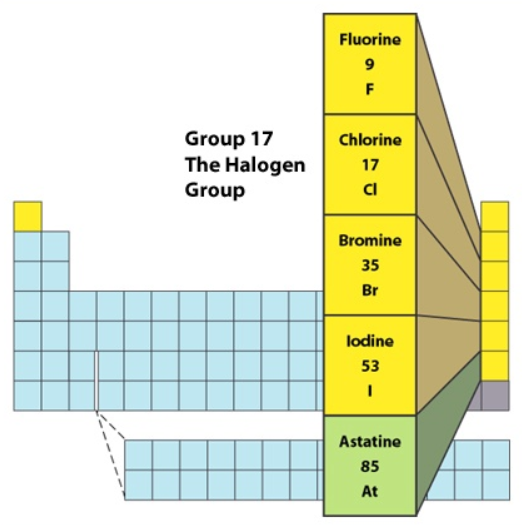p-Block Elements: Group 17
General Introduction

The elements of group 17 are a part of the halogen family. The family name means “salt-forming. They were given the name from the Greek roots Hal- (“salt”) and –gen (“to produce”) because they all produce sodium salts of similar properties. Halogens are very reactive non-metallic elements and most of them exist naturally as halide salts. The halogen molecules exist as diatomic molecules: F2, Cl2, Br2, I2, and At2. Except for astatine, a radioactive metalloid, all the other elements in Group 17 are nonmetals. Each halogen is the most electronegative element in its respective row.
Before antiseptics, iodine was used to clean wounds as it is harmful to all things, including bacteria. But iodine is highly toxic and reactive. They are not found free diatomic molecules in nature because of their reactivity – they are found as compounds with metals. Halogens can also react with other non-metals. For example, fluorine is so reactive that it can even form bonds with noble gases such as xenon. Xenon(II) fluoride (XeF2) is made by the reaction of xenon and fluorine, using heat or electricity to provide the activation energy. It is used to etch patterns on silicon chips. If XeF2 is heated, it reacts to form xenon(VI) fluoride, XeF6.
Halogens react with metals to produce compounds called halides. Many naturally-occurring halides are utilized in industrial, household and medical industries rigorously.
- Halogen + metal ionic salt
- Halogen + non-metal covalent molecule
The group 17 elements act as an oxidizing agent in displacement reactions between halide ions and halogen that is higher in reactivity. This means that the halogenoxidizes the halide ion to the halogen and gains electrons. Halogen is thereby reduced to form the halide ion.
Fluorine is the most reactive of the halogens in combining with other elements followed by chlorine, bromine, iodine and astatine. Fluorine is most well known for constructing fluorides, which prevents tooth decay. Fluorine, F2is used in CFC’s, polymers – PTFE poly(tetrafluoroethylene) as used innon-stick frying pans, electrical insulation, water proof clothing. Tin fluoride is added to toothpaste. Sodium fluoride is added to water supplies. Hydrogenfluoride, HF is used to etch glass.
Chlorine, Cl2 is used in water purification, bleach, solvents, polymers – poly(chloroethene) or PVC, CFC’sand as an oxidizing agent in many pharmaceutical products. Chlorine is used to purify water supplies because it is toxic to bacteria, some of which can cause disease. Adding it to water supplies is therefore beneficial for the population.
Bromine is used primarily in insecticides and agricultural chemicals. It is also used in flame retardants. Silverbromide, AgBr is used in photographic film.
Iodine is used in old photos, printing inks and dyes, and is used in salts as a supplement.
Fluorine gas, chlorine gas, bromine vapour and iodine vapour are toxic to the human body. Therefore, we must handle them in a fume chamber because their fumes are toxic pollutants. Handling the halogens require wearing safety goggles and gloves. There is no known usage of astatine considering its incredibly high radioactivity.